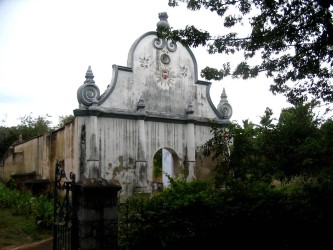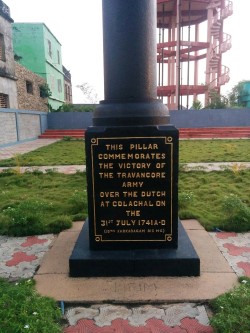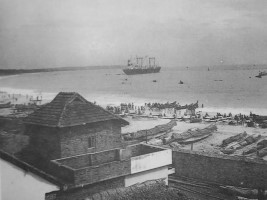A Great Captain
Ulloor S. Parameswara lyer
Eustachius Benedictus De Lannoy was a native of Belgium, and a Roman Catholic by religion. He was born in 1715 A. D.,
and early in life joined the army of the Netherland East India Company. He soon became an expert in the construction of fortifications.
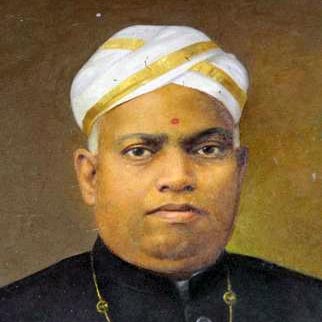
Ulloor S. Parameswara lyer
Stop way farer
Here lies Eustachius Benedictus De Lannoy, who as the General-in-chief of the troops of Travancore was in command, and for nearly 37 years served the king with the utmost fidelity.
By the might of his arms and the fear (of the name), he subjected to his (the king's)way all the kingdoms from Kayamkulam to Cochin.
He lived 62 years and 5 months and died on the 1st June 1777.
May he rest in peace.
De Lannoy at Colachel- Colachel is an old sea-port of South Travancore. The Netherland East India Company, which possessed large-scale territorial ambitions in Kerala, came into conflict with Maharaja Marthanda Varma, the great king of Travancore who was gradually extending his sway over neighbouring principalities, and commenced a systematic campaign against him on several fronts and helped one country after another for arresting the march of that far-sighted conqueror with men and materials. Matters came to a head in 1740, and in January, 1741, Colachel was forcibly occupied by the Dutch with the object of seizing the whole country from that port up to Cape Comorin where the Company had a sale-factory with fort and garrison. In the secret letter to Batavia dated the 12th May 1941, the desirability of making that area a Dutch province was emphasised “as it is the most beautiful district in Malabar and the wealthiest of all places there". Martanda Varma saw through this scheme, and early in August 1741, before reinforcements could arrive from Ceylon, attacked the Dutch garrison at Colachel, aided by his distinguished minister and generalissimo, Ramaiyan Dalawa. The garrison surrendered on the 7th August, a red-hot bale having ignited a barrel of gun-powder and caused a conflagration in the blockade in which the whole of the rice supply was consumed. Not one man escaped and all were taken as captives. Among them were De Lannoy and Donadi. Donadi was subsequently employed to supervise the renovation of the fort round the palace in Trivandrum.
De Lannoy not a deserter - There was already a general in the Travancore army who was a deserter from the Dutch army, in which he had been employed as Sergeant. His name was Duyvenschot. He took a leading part in the wars which Travancore waged with the Dutch from 1739 to 1742, and particularly in the Campaign against Quilon. The Dutch Governor of Cochin Adriaan Moens, couples De Lannoy with him, and states: "These men not only understood their military duties and conducted them, well but had besides fairly good knowledge of fortification and the art of war, having been trained in Europe and gained some experience also. They could not however rise above the post of Sergeant in the Company's services and several times found less efficient men going over their heads, so that first the one and then the other enlisted in the army of the king of Travancore, and in that well-known, and I may say ruinous, Travancore war in which the Company lost so many men and so much money, showed of what use they could be to Travancore and how much harm they could do us"! De Lannoy was not a deserter in the sense in which Duyvenschot was. He joined the Travancore army only in 1741, after the battle of Colachel.
His early military career in Travancore - The European prisoners secured at Colachel were stationed in the Udayagiri Fortress .and treated with great consideration by the Maharajah. De Lannoy entered the service of the Maharajah, whose special attention he attracted by his military insight. He was first entrusted with the organisation and training of a special regiment and soon after raised to the rank of a Captain to look after the construction and repair of fortifications. He was also placed in special charge of arsenals. There were several fortresses in Travancore constructed in previous time, e.g., the forts of Kalkulam and Udayagiri in South Travancore, but they had not been properly maintained. This responsible duty was also discharged by him satisfactorily. He next reorganised the entire Travancore army on the western model, and made it thoroughly efficient in the wars that ensued from 1746. He then commanded a division of the army in the war against the Kayamkulam Raja, the other two divisions being under the command of Maharaja Rama Varma, the heir-apparent to the throne, and Ramaiyan Dalawa, respectively. That principality was brought under subjection in 1748. The neighbouring territories of Tekkumkur and Ampalappuzha were also conquered before the end of 1749, and the Maharaja dedicated the whole of his territory from Tovala to the Minachal River to his tutelary Deity Sree Padmanabha, in 1750.
De Lannoy was then appointed Commander in-chief - of the Travancore forces and raised to the rank of General, subject, of course, to the superior control of the Dalawa from time to time. By that time he had not only reconstructed the forts of Udayagiri and Kalkulam, but also established an arsenal at Udayagiri where arms and ammunitions of different kinds were manufactured on a large scale. A long line of stone walls was erected from Aramboli to Cape Comorian, known as the Aramboli fort and battens were constructed on the sea-coast at different places from Cape Comorin to Ampalappuzha. Several forts in Central and North Travancore were also rejuvenated and fresh forts erected wherever necessary in due course. He derived intelligent and effective help and support in the reforms first from Ramaiyan Dalawa, and next from Aiyyappan Marthanda Pillai Dalawa, Ramaiyan's successor as Prime Minister. The strength of the army was raised and besides 50,000 well-disciplined troops consisting of cavalry, infantry and artillery, an irregular force of 100,000 trained men in the traditional method of warfare, was organised and maintained by Travancore at the time of his death. The principality of Vatakkumkur was next annexed. The Dutch had entered into a treaty with Travancore at Mavelikkara in 1753, which tolled the death-knell of the Company's power and prestige on the Malabar Coast. In 1757, Cochin concluded a similar treaty with Travancore, for fear of subjugation by the Zamorin of Calicut. Maharaja Martanda Varma passed away in 1758 and he was succeeded by his nephew Rama Varma, already referred to, who showed equal consideration to De Lannoy. In 1762 Travancore took the field against the Zamorin, who had by that time overrun the whole of Cochin, and the Travancore army, there upon, under the command of Dalawa Marthanda Pillai and General De Lannoy, attacked his army at three points, viz., Cranganore, Parur and Veraboly and drove him back to his own dominions. De Lannoy then advanced as far as Kunnankulam at the northern extremity of Cochin to invade the Zamorin’s territories. This was, however, rendered unnecessary by the Zamorin seeking the protection of Maharaja Rama Varma, and concluding a treaty with him in 1763.
Construction of the Travancore Lines - De Lannoy’s name is most prominently associated with the construction of the famous “Travancore Lines”. This was a defensive fortification, stretching more or less in a straight line from the shore of the backwater opposite to the town of Cranganore right up to the foot of the Western Ghats. It consisted of an earthen rampart, extending over thirty miles in length, along a portion of the Cochin State ceded by the Raja of that State with a ditch in the north and slanting towers at appropriate strategical points together with a well-constructed fort at the western extremity. These lines substantially protected Travancore from invasions from the north and helped not a little in inflicting a crushing blow on Tippu Sultan of Mysore when he proceeded against Travancore in 1789. “The resistance offered by Travancore” states A Galletti in his Dutch in Malabar, “to the formidable armies of Mysore at a time when they were disputing the British supremacy in South India is a historical fact of no small importance”. Hider Ali invaded Malabar in 1773, and in 1776 owing to the difficulty of penetrating the Travancore Lines, demanded a free passage for his army to Travancore through the Dutch forts of Cranganore and Ayakotta, which planted the western extremity of those Lines. This request was promptly refused. De Lannoy visited the Lines again and gave the final touches to them.
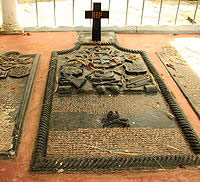
De Lannoy's Tomb at Udayagiri Fort Death of De Lannoy: De Lannoy had already made the Udayagiri fort his place of residence. The Government of Travancore, at his request, built a Roman Catholic Chapel there and employed a Vicar at their own cost to be in charge of it. This served as a place of worship for other foreign catholic; soldiers of the Travancore army as well. The general was a very pious Christian, and mainly through his influence, several new places of plebeian worship were erected and endowed by rulers under whom he served. It may be stated here that Travancore has always been very generous in the treatment of Non-Hindus and that religious toleration was its motto.
The General died on the 1st of June, 1777, after a strenuous life of 62 years and five months, nearly 37 of which were spent in the service of Travancore. His uncommon wisdom, intrepid courage, steadfast loyalty and unflinching devotion to duty endeared him to every Travancorean, who revered him as “the Valiya Kappithan”, i.e., “the Great Captain” of the State. His mortal remains were interred in the Udayagiri Chapel. There is on his tomb-stone a Latin epitaph, and an expanded version of it in Tamil. The following is the English translation of the Latin epitaph.
Stop way farer
Here lies Eustachius Benedictus De Lannoy, who as the General-in-chief of the troops of Travancore was in command, and for nearly 37 years served the king with the utmost fidelity.
By the might of his arms and the fear (of the name), he subjected to his (the king's)way all the kingdoms from Kayamkulam to Cochin.
He lived 62 years and 5 months and died on the 1st June 1777.
May he rest in peace.
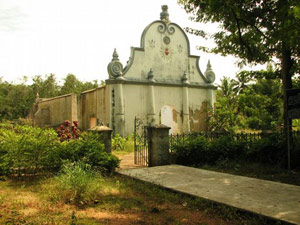
Family: He married a widow from Anjengo by name Margarita. Anquetil Du Pierron, the French Traveller and savant says in 1758 that a story had been current to the effect that the father of the woman was not in favour of the alliance, whereupon, Maharaja Marthanda Varma had to intercede and secure the influence of the factor of Anjengo to secure his consent. The marriage, however proved a happy one. They had only one son, Johnnes, who was born on the 5th August 1745, and who lost his life on the 14th September 1765, having been fatally wounded in the storming of the Fort of Kalakkad which is now a portion of British India, and which then belonged to Travancore. After his son's death, the General felt greatly distressed and he grew prematurely old. Margarita (Margaret) was also charitably disposed and an account of the visit of Joseph, Metropolitan of Kariyat, to her in 1778, is described in a contemporary Malayalam prose work named Vartamanappustakam. She had then got down a young Eurasian by name Wattayi from Calicut to wed her daughter. Maharaja Rama Varma had allowed her, by way of pension, the full pay received by her husband. Margarita died in the Udayagiri Fort on the 11th September 1782. There are Latin and Tamil epitaphs over the tombs of both her son and herself also near that of General De Lannony in the Udayagiri Chapel.
Notes and References
'A great Captain' is an unpublished life-sketch of a Dutch soldier named De Lannoy. In 1760, after the defeat of the Dutch at Colachel, King Martanda Varma the maker of modern Travancore, took two of their men as prisoners. They were De Lannoy and Donadi. The King who was pleased by the military knowledge of De Lannoy soon appointed him a captain in his service. He instructed the native soldiers in the art of war. After some time he became the Commander-in-Chief of the Travancore forces. In this capacity he made everything that was required for the defence of the country and thoroughly reorganised its military force. It was during his time that most of the Forts in Travancore were reconstructed. For all the service he is gratefully remembered as the great captain who established European discipline in the Travancore Army. When this architect of the Travancore army died, he was buried in his own church at Udayagiri with full military honours. His tomb is still seen in the ruined chapel inside the fort now overgrown with jungle.
1. Galatti: A Dutch historian who gives an account of the Netherland East India Company's days in the south in his work "Dutch in Malabar".
2. Vartamanapustakam: The first book in Malayalam on travel. The author is a clergyman by name Paremakkal Thoma. The book gives an account of his journey from Goa to Rome on religious purpose. Ouseph Malpan was a fellow traveller.
English Essays and Poems by Mahakavi Ulloor - Kerala University Publication -1978
